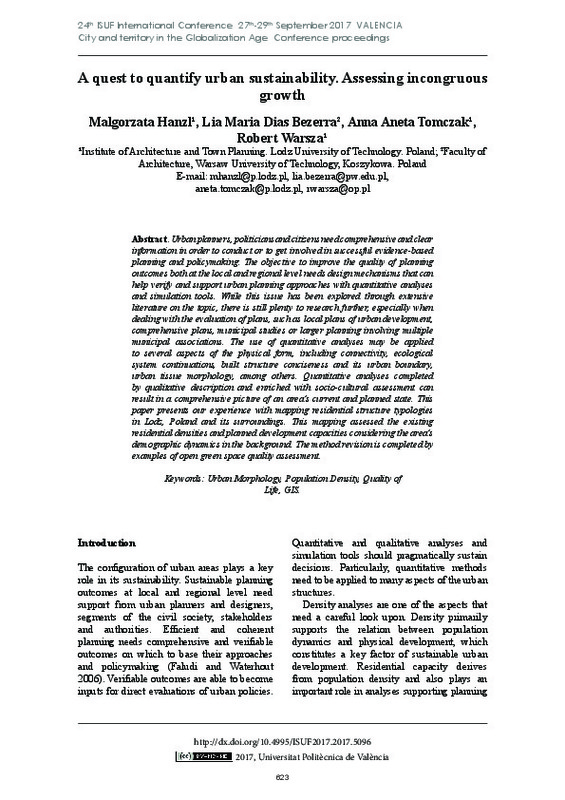JavaScript is disabled for your browser. Some features of this site may not work without it.
Buscar en RiuNet
Listar
Mi cuenta
Estadísticas
Ayuda RiuNet
Admin. UPV
A quest to quantify urban sustainability. Assessing incongruous growth
Mostrar el registro sencillo del ítem
Ficheros en el ítem
| dc.contributor.author | Hanzl, Malgorzata
|
es_ES |
| dc.contributor.author | Bezerra, Lia Maria
|
es_ES |
| dc.contributor.author | Tomczak, Anna
|
es_ES |
| dc.contributor.author | Warsza, Robert
|
es_ES |
| dc.date.accessioned | 2018-12-05T08:28:58Z | |
| dc.date.available | 2018-12-05T08:28:58Z | |
| dc.date.issued | 2018-04-20 | |
| dc.identifier.isbn | 9788490485743 | |
| dc.identifier.uri | http://hdl.handle.net/10251/113474 | |
| dc.description.abstract | [EN] Urban planners, politicians and citizens need comprehensive and clear information in order to conduct or to get involved in successful evidence-based planning and policymaking. The objective to improve the quality of planning outcomes both at the local and regional level needs design mechanisms that can help verify and support urban planning approaches with quantitative analyses and simulation tools. While this issue has been explored through extensive literature on the topic, there is still plenty to research further, especially when dealing with the evaluation of plans, such as local plans of urban development, comprehensive plans, municipal studies or larger planning involving multiple municipal associations. The use of quantitative analyses may be applied to several aspects of the physical form, including connectivity, ecological system continuations, built structure conciseness and its urban boundary, urban tissue morphology, among others. Quantitative analyses completed by qualitative description and enriched with socio-cultural assessment can result in a comprehensive picture of an area’s current and planned state. This paper presents our experience with mapping residential structure typologies in Lodz, Poland and its surroundings. This mapping assessed the existing residential densities and planned development capacities considering the area’s demographic dynamics in the background. The method revision is completed by examples of open green space quality assessment. | es_ES |
| dc.format.extent | 10 | es_ES |
| dc.language | Inglés | es_ES |
| dc.publisher | Editorial Universitat Politècnica de València | es_ES |
| dc.relation.ispartof | 24th ISUF International Conference. Book of Papers | es_ES |
| dc.rights | Reconocimiento - No comercial - Sin obra derivada (by-nc-nd) | es_ES |
| dc.subject | Urban morphology | es_ES |
| dc.subject | Population density | es_ES |
| dc.subject | Quality of life | es_ES |
| dc.subject | GIS | es_ES |
| dc.title | A quest to quantify urban sustainability. Assessing incongruous growth | es_ES |
| dc.type | Capítulo de libro | es_ES |
| dc.type | Comunicación en congreso | es_ES |
| dc.identifier.doi | 10.4995/ISUF2017.2017.5096 | |
| dc.rights.accessRights | Abierto | es_ES |
| dc.description.bibliographicCitation | Hanzl, M.; Bezerra, LM.; Tomczak, A.; Warsza, R. (2018). A quest to quantify urban sustainability. Assessing incongruous growth. En 24th ISUF International Conference. Book of Papers. Editorial Universitat Politècnica de València. 623-632. https://doi.org/10.4995/ISUF2017.2017.5096 | es_ES |
| dc.description.accrualMethod | OCS | es_ES |
| dc.relation.conferencename | 24th ISUF 2017 - City and Territory in the Globalization Age | es_ES |
| dc.relation.conferencedate | Septiembre 27-29,2017 | es_ES |
| dc.relation.conferenceplace | Valencia, Spain | es_ES |
| dc.relation.publisherversion | http://ocs.editorial.upv.es/index.php/ISUF/ISUF2017/paper/view/5096 | es_ES |
| dc.description.upvformatpinicio | 623 | es_ES |
| dc.description.upvformatpfin | 632 | es_ES |
| dc.type.version | info:eu-repo/semantics/publishedVersion | es_ES |
| dc.relation.pasarela | OCS\5096 | es_ES |








